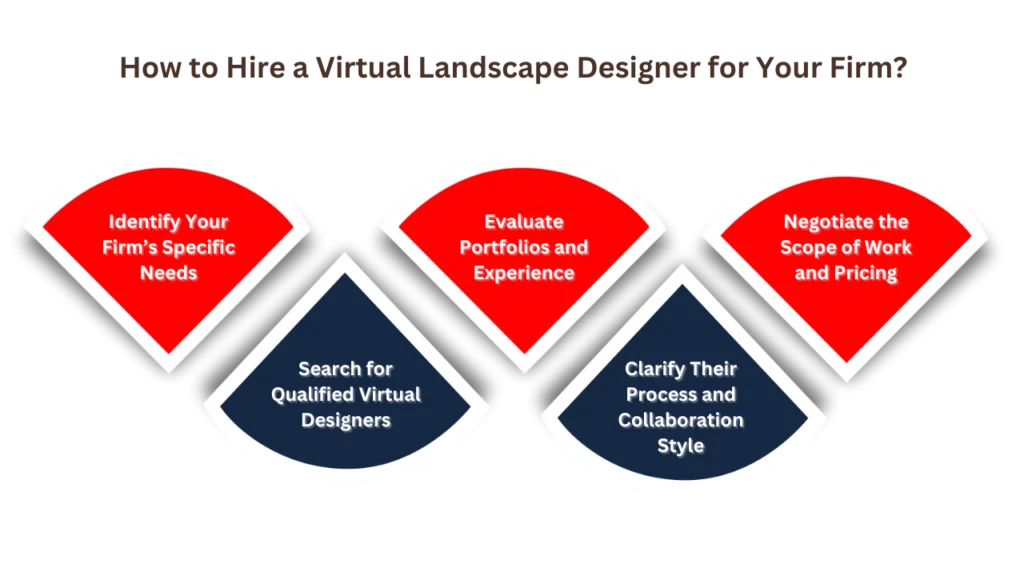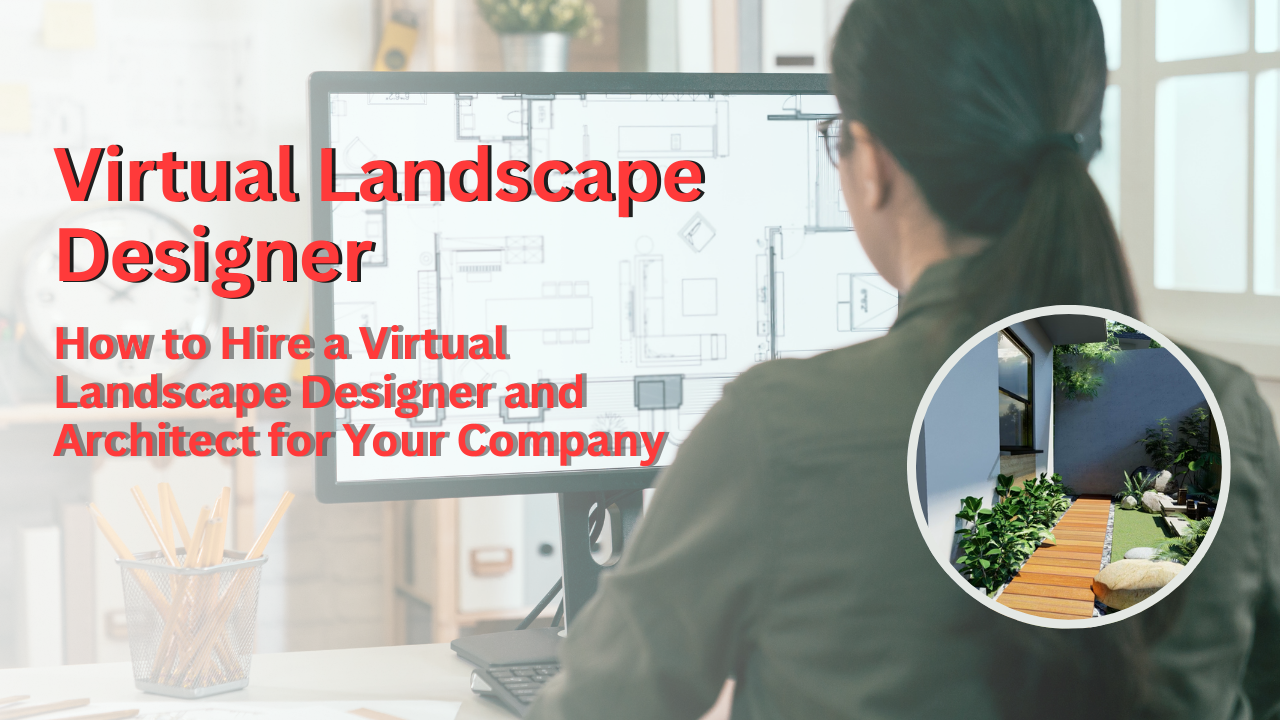If you’re managing a mid-sized design or architecture firm and seeking ways to expand your service offerings, enhance team productivity, and optimize costs, integrating a virtual landscape designer or architect into your workflow can be a highly effective strategy.
Whether you’re tackling multiple projects or your in-house team is overwhelmed with demand, adding virtual landscape designers to your roster can enhance your team’s flexibility and deliver high-quality designs without the overhead of traditional hiring.
In this guide, we’ll break down how mid-sized firms like yours can benefit from hiring virtual landscape designers and architects, and how to successfully integrate these professionals into your workflow.
Why Virtual Landscape Designers Are a Smart Choice for SMEs
For a firm that’s growing, finding cost-effective ways to scale without compromising quality is key. By hiring a virtual landscape designer, you gain access to specialized talent without the need for a permanent in-house hire. Here’s why it works so well:
- Increased flexibility: Virtual landscape designers offer on-demand expertise. You can bring them in for specific projects when needed, whether it’s seasonal demand or a one-off large project.
- Access to diverse skill sets: Your firm can tap into a wider talent pool. Whether you need someone experienced with modern urban spaces, rooftop gardens, or sustainable landscapes, virtual designers can provide specialized skills to complement your in-house team.
- Cost savings: No need for office space, employee benefits, or long-term contracts. You can hire virtual designers on a per-project basis, allowing you to control costs while maintaining high standards of work.
- Scalability: As your client base grows, you can quickly scale up your design capacity by hiring multiple virtual designers or architects to meet project demands.
What Can a Virtual Landscape Designer Offer Your Firm?
Virtual landscape designers are capable of handling everything from 2D and 3D landscape designs to detailed CAD plans and plant selection lists. This makes them an excellent resource for mid-sized firms needing versatile support across a range of outdoor projects.
Here’s what you can expect when hiring a virtual landscape designer:
- Custom landscape designs tailored to your client’s needs and environmental considerations.
- 3D renderings and visualizations to help clients understand what the finished project will look like. This is especially useful when pitching ideas or getting client approval.
- Detailed site plans that include plant lists, hardscaping elements, lighting, and furniture arrangements.
- CAD drawings for complex projects that require precision, especially for features like pools, terraces, or irrigation systems.
By integrating these services into your firm’s operations, you can offer a comprehensive design package to your clients while maintaining efficiency.
How to Hire a Virtual Landscape Designer for Your Firm

Finding the right virtual landscape designer or architect for your firm requires a bit of research, but the process is straightforward. Here are the steps to follow:
1. Identify Your Firm’s Specific Needs
Before you start searching for a virtual designer, it’s crucial to define your firm’s requirements. Are you looking for someone who specializes in commercial landscape design, residential projects, or a particular style, such as modern or sustainable landscapes? Perhaps your team needs support with 3D renderings or detailed CAD plans.
Some key factors to consider include:
- Scope of projects: Will the designer work on multiple projects simultaneously, or is it a one-time contract for a specific job?
- Specialized expertise: Does your firm need specific skills like pool design, rooftop garden layouts, or sustainable plant selection?
- Software proficiency: Ensure the designer is proficient with the design tools and software your team uses, such as AutoCAD, SketchUp, or Photoshop for rendering.
2. Search for Qualified Virtual Designers
Once you’ve defined your needs, it’s time to start looking for the right designer or architect. There are several ways to do this:
- Design platforms and websites: Use specialized platforms like Invedus, Houzz, Upwork, or other professional networks where landscape designers and architects showcase their portfolios.
- Referrals: Reach out to industry contacts or professionals in related fields who may have worked with virtual designers in the past.
- Online agencies: Firms like Invedus provide virtual landscape designers that can seamlessly integrate into your team. These agencies pre-vet designers, which can save you time in the hiring process.
3. Evaluate Portfolios and Experience
When hiring virtually, it’s important to thoroughly evaluate a designer’s portfolio. Look for past work that aligns with the types of projects your firm handles. Are they experienced in designing commercial outdoor spaces or more familiar with residential landscapes?
Check for:
- Diversity in their portfolio: Do they have experience with different styles, climates, and client needs?
- Visual quality of their renderings: Are their 3D visualizations detailed and realistic? Do their 2D plans include the necessary technical elements, such as drainage and planting zones?
- Project complexity: Have they worked on projects of a similar scale to what your firm handles? If your firm often deals with large commercial spaces, make sure the designer is comfortable managing these kinds of projects.
4. Clarify Their Process and Collaboration Style
Since you’ll be working remotely with your virtual designer, clear communication and a streamlined workflow are crucial. Ask them about their process for collaborating with firms like yours:
- How do they present initial concepts? Do they offer 2D sketches, 3D models, or virtual walkthroughs?
- What software do they use? Ensure they’re proficient with the tools your firm uses so that collaboration is smooth.
- What’s their timeline for delivering designs? Make sure their schedule aligns with your firm’s project deadlines.
- How do they handle revisions? Ask about their process for making changes and how many rounds of revisions are included in their services.
Clear communication from the start will help prevent misunderstandings later in the project.
5. Negotiate the Scope of Work and Pricing
Once you’ve selected a designer, you’ll need to agree on the scope of work and pricing. Many virtual designers offer tiered packages based on the complexity of the project. For example, a basic package might include conceptual designs and a 2D plan, while a more comprehensive package could include 3D renderings, plant lists, and detailed CAD drawings.
Be sure to discuss:
- Project scope: Clarify which parts of the design process the virtual designer will handle. Will they be responsible for everything from concept to final plan, or just certain elements?
- Pricing structure: Is the designer charging a flat fee, hourly rate, or per project? For ongoing work, it might be more cost-effective to agree on a retainer or a bulk project rate.
- Revisions: Ensure you know how many revisions are included in the price, and what happens if the project goes beyond the initial agreement.
How a Virtual Landscape Designer Can Boost Your Firm’s Productivity
Hiring a virtual landscape architect doesn’t just help with workload management; it can also significantly increase your firm’s productivity. Here’s how:
- Delegation of routine tasks: By outsourcing repetitive tasks like drafting site plans or creating 3D visualizations, your in-house team can focus on higher-level project management and client interactions.
- Faster turnaround times: Virtual designers often work independently, meaning they can focus solely on the design process without being interrupted by daily office tasks. This can lead to quicker project completion.
- On-demand scalability: When project demands surge, such as during peak seasons, having virtual designers on-call allows you to scale your workforce quickly without the need for permanent hires.
Integrating Virtual Designers into Your Workflow
To fully benefit from virtual designers, it’s important to have a system in place that integrates them smoothly into your firm’s workflow. Here are a few tips:
- Establish clear communication channels: Use communication tools like Slack, Zoom, or Microsoft Teams for regular check-ins and collaboration.
- Use cloud-based project management tools: Platforms like Asana or Trello can help keep track of tasks, deadlines, and revisions, ensuring everyone is on the same page.
- Collaborative design tools: If your team uses design software like AutoCAD or SketchUp, ensure that your virtual designers have access to shared files and can collaborate in real time.
To Conclude
For SMEs looking to boost their expertise, enhance flexibility, and manage costs, hiring a virtual landscape designer or architect is a strategic move.
Not only does it allow your firm to scale according to project demands, but it also opens up access to a broad talent pool that can bring fresh, innovative ideas to your projects.
By following the steps outlined in this guide, you can ensure a smooth and successful partnership with virtual designers, delivering exceptional landscape designs that boost your firm’s offerings and satisfy your clients.
How Invedus Can Help?
Invedus offers top-tier remote and virtual employees, including expert landscape designers and architects, who can seamlessly integrate into your team to provide flexible, cost-effective solutions.
Our professionals specialize in advanced 3D modeling and rendering services, helping your firm deliver high-quality visualizations and designs that impress clients and streamline project execution.
Whether you need on-demand talent or long-term collaboration, Invedus ensures your projects are in skilled hands while saving your firm time and resources. Contact Us Today!








